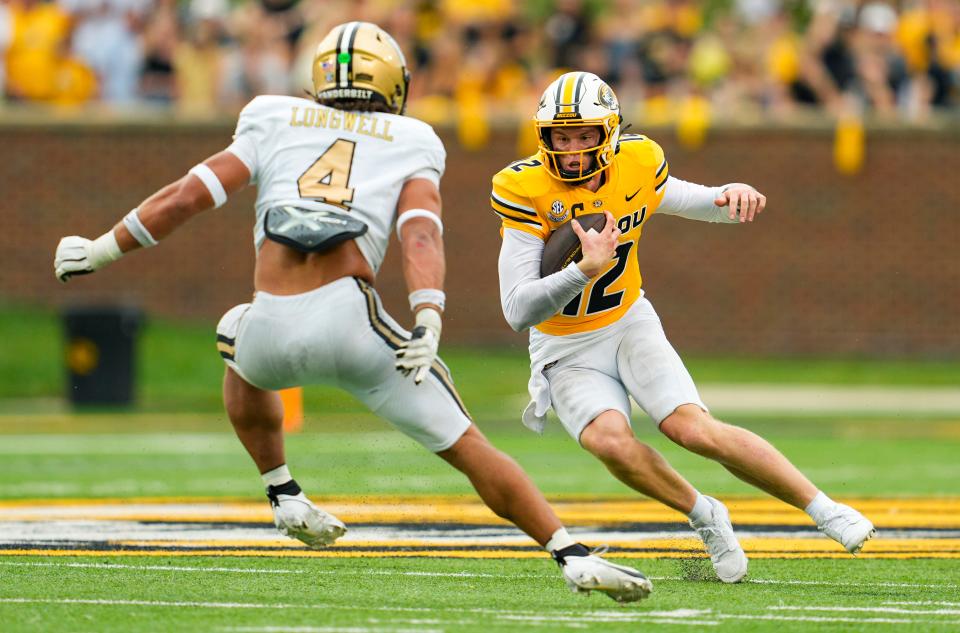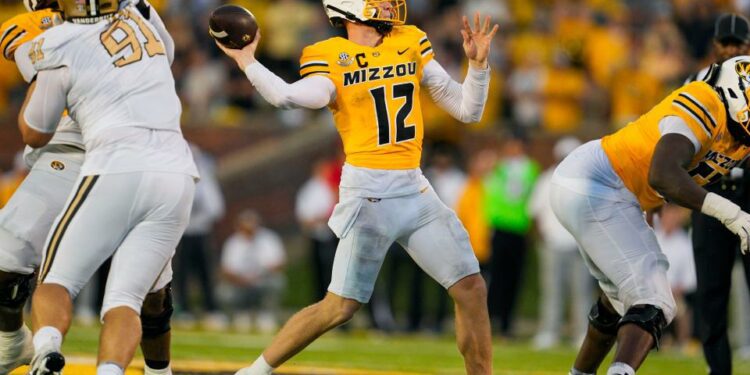Missouri football has had a couple close calls.
The Tigers had to come from behind to beat a ranked Boston College team Sept. 14, but probably could have had that one-score game finished earlier. Then, Mizzou went all the way to double-overtime before seeing off Vanderbilt last Saturday.
No. 11-ranked Missouri is surviving, but it isn’t quite thriving.
Busted coverages for touchdowns have played a part. Drive-busting penalties and kicking issues have reared. But there seems to be one clear recurring issue.
“I mean, that’s the unfortunate thing right now. We’re just not able, in the red zone, to finish drives,” Missouri coach Eli Drinkwitz said after the Vanderbilt matchup. “And we’ve got take a really hard look at that on what we’re not able to do in the red zone and why we’re not able to get touchdowns in there. You know, the three field goal (misses)? At the end of the day, we’ve got to be scoring touchdowns.”
More: Why Missouri football QB Brady Cook wasn’t relieved after double-OT escape
More: Missouri football tumbles out of top 10 in coaches poll after double-OT win over Vanderbilt
With a third of Missouri’s regular season in the books, it’s not a far-flung assumption that a fair chunk of the playbook is on tape.
The Tigers don’t look particularly adventurous in the passing game. Their bread and butter has been short-yardage throws, a reliance on yards after the catch from their playmakers and a rushing attack that is clicking on all fronts. The deep ball hasn’t developed yet, and until proven otherwise doesn’t appear to be a big part of the plan.
The Tigers are sustaining drives with the eighth-best third-down completion rate (54.7%) in the FBS. Even against Vanderbilt and Boston College, that ratio is sitting at 50%. Most of what MU is trying to do is just about working.
Until it isn’t.
Like Drinkwitz said postgame Saturday, an inability to convert drives into touchdowns has made two straight games nervous. The Tigers aren’t putting games to bed, even if the red-zone numbers aren’t abysmal.
When Mizzou got down to the red zone (in regulation) in its games against BC and Vandy, the Tigers converted eight trips into four touchdowns, three field goals and one FG miss.
That kind of ratio will work, most of the time.
But let’s take a step back … or 10.


Sep 21, 2024; Columbia, Missouri, USA; Missouri Tigers quarterback Brady Cook (12) throws a touchdown pass against the Vanderbilt Commodores during overtime at Faurot Field at Memorial Stadium. Mandatory Credit: Jay Biggerstaff-Imagn Images
Missouri got inside the opponent’s 30-yard line 11 times over the course of those two games. It’s not quite the red zone, but it is field goal range and that makes it scoring range.
The Tigers scored on eight of those 11 trips, with three missed field goals. They converted four trips into touchdowns and four into field goals.
If we’re calling that a maximum of 66 points (11 touchdowns) by excluding the PAT or 2-point decision, Mizzou came away with 36 points.
That kind of ratio will not work, most of the time.
Here’s, potentially, a reason why:
On the drives that made it inside 30 yards to goal, Mizzou ran 28 total offensive plays: Thirteen were handoffs to running backs; four were QB runs; 10 were passes; and there was one sack.
Five of the 10 passes did not travel past the line of scrimmage. Four of the 10 went incomplete, including a couple that were impacted by defensive pressure.
The biggest play was a wheel route pass to Marcus Carroll against Vanderbilt, which went 19 yards. In the same game, a Nate Noel run went 17 yards on a post-penalty first-and-long. Those are the only two plays — among 28 opportunities — that gained more than seven yards.
Of the 28 snaps, 21 resulted in a gain of three yards or less.
The average play traveled 2.1 yards.
Missouri has been a methodical team on offense. But there’s conservative play-calling, and then there’s 2.1-yards-per-attempt play-calling.


Sep 21, 2024; Columbia, Missouri, USA; Missouri Tigers quarterback Brady Cook (12) runs the ball against Vanderbilt Commodores linebacker Bryan Longwell (4) during the second half at Faurot Field at Memorial Stadium. Mandatory Credit: Jay Biggerstaff-Imagn Images
The offense is ticking just about everywhere that isn’t scoring range. There could be any number of reasons for that, spanning from pass protection, which Drinkwitz didn’t see any glaring weaknesses in, to quarterback play, to route-running, to decision-making, to … well, just about anything.
There’s the task for offensive coordinator Kirby Moore and the offensive staff. The Tigers need to tick all the way to the goal line.
Missouri, over the course of its season, is earning 6.1 yards per play on offense, which is a top-50 mark in the country.
Inside the 30-yard line against Vandy and BC, it earned about one-third of that.
That’s a disconnect, and one that needs to be solved.
“We’re 4-0, and we’ve got a lot of work to do,” Drinkwitz said Saturday. “You know, there were some (real) positives, as far as the way we ran the football, but not good enough in the red zone, for sure, when we’re kicking that many field goals.”
This article originally appeared on Columbia Daily Tribune: Why Missouri football offense’s drives are stalling in scoring position
Source link : http://www.bing.com/news/apiclick.aspx?ref=FexRss&aid=&tid=66f3e99065014b5eadf894dea6ceac83&url=https%3A%2F%2Fsports.yahoo.com%2Fdiving-why-missouri-football-offense-080822948.html%3Ffr%3Dsycsrp_catchall&c=14901041644476607102&mkt=en-us
Author :
Publish date : 2024-09-24 21:08:00
Copyright for syndicated content belongs to the linked Source.





